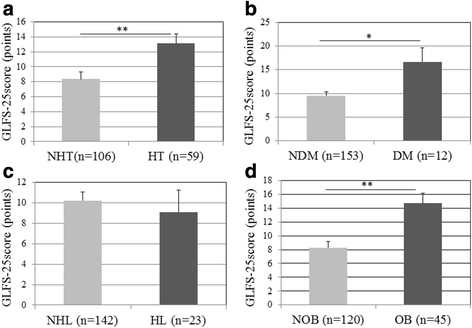Locomotive syndrome is associated with body composition and cardiometabolic disorders in elderly Japanese women
- PMID: 27677265
- PMCID: PMC5039907
- DOI: 10.1186/s12877-016-0339-6
Locomotive syndrome is associated with body composition and cardiometabolic disorders in elderly Japanese women
Abstract
Background: A concept referred to as locomotive syndrome (LS) was proposed by the Japanese Orthopaedic Association in order to help identify middle-aged and older adults who may be at high risk of requiring healthcare services because of problems associated with locomotion. Cardiometabolic disorders, including obesity, hypertension, diabetes, and dyslipidemia, have a high prevalence worldwide. The purpose of this study was to determine the associations between LS and both body composition and cardiometabolic disorders.
Methods: The study participants were 165 healthy adult Japanese women volunteers living in rural areas. LS was defined as a score ≥16 on the 25-question Geriatric Locomotive Function Scale (GLFS-25). Height, body weight, body fat percentage, body mass index (BMI), and bone status were measured. Bone status was evaluated by quantitative ultrasound (i.e., the speed of sound [SOS] of the calcaneus) and was expressed as the percent of Young Adult Mean of the SOS (%YAM). Comorbid conditions of hypertension, hyperlipidemia, and diabetes were assessed using self-report questionnaires.
Results: Twenty-nine participants (17.6 %) were classed as having LS. The LS group was older, shorter, and had a higher body fat percentage, a higher BMI, and lower bone status than the non-LS group. Multiple logistic regression analysis showed that participants with a BMI ≥23.5 kg/m2 had a significantly higher risk for LS than those with a BMI <23.5 kg/m2 (odds ratio [OR] = 3.78, p < 0.01). Furthermore, GLFS-25 scores were higher in participants with than those without hypertension, diabetes, or obesity, and significantly increased with the number of present disorders.
Conclusions: These findings suggest that BMI may be a useful screening tool for LS. Furthermore, because hypertension and diabetes were associated with LS, the prevention of these disorders accompanied by weight management may help protect against LS.
Keywords: Body composition; Bone mass index; Cardiometabolic disorders; Locomotive syndrome.
Figures


Similar articles
-
Cognitive impairment associated with locomotive syndrome in community-dwelling elderly women in Japan.Clin Interv Aging. 2017 Sep 12;12:1451-1457. doi: 10.2147/CIA.S142538. eCollection 2017. Clin Interv Aging. 2017. PMID: 28979107 Free PMC article.
-
Population-based study of the association of osteoporosis and chronic musculoskeletal pain and locomotive syndrome: the Katashina study.J Orthop Sci. 2015 Nov;20(6):1085-9. doi: 10.1007/s00776-015-0774-9. Epub 2015 Sep 7. J Orthop Sci. 2015. PMID: 26345242
-
The Relationship between Locomotive Syndrome and Depression in Community-Dwelling Elderly People.Curr Gerontol Geriatr Res. 2017;2017:4104802. doi: 10.1155/2017/4104802. Epub 2017 Apr 5. Curr Gerontol Geriatr Res. 2017. PMID: 28479917 Free PMC article.
-
Clinical characteristics of locomotive syndrome categorised by the 25-question Geriatric Locomotive Function Scale: a systematic review.BMJ Open. 2023 May 16;13(5):e068645. doi: 10.1136/bmjopen-2022-068645. BMJ Open. 2023. PMID: 37192799 Free PMC article.
-
Epidemiology of the locomotive syndrome: The research on osteoarthritis/osteoporosis against disability study 2005-2015.Mod Rheumatol. 2017 Jan;27(1):1-7. doi: 10.1080/14397595.2016.1226471. Mod Rheumatol. 2017. PMID: 27538793 Review.
Cited by
-
Association of visceral fat area with early-stage locomotive syndrome across various age groups: a cross-sectional study.Sci Rep. 2024 Oct 26;14(1):25498. doi: 10.1038/s41598-024-76478-8. Sci Rep. 2024. PMID: 39462134 Free PMC article.
-
White matter fiber-specific degeneration in older adults with metabolic syndrome.Mol Metab. 2022 Aug;62:101527. doi: 10.1016/j.molmet.2022.101527. Epub 2022 Jun 9. Mol Metab. 2022. PMID: 35691528 Free PMC article.
-
Cognitive impairment associated with locomotive syndrome in community-dwelling elderly women in Japan.Clin Interv Aging. 2017 Sep 12;12:1451-1457. doi: 10.2147/CIA.S142538. eCollection 2017. Clin Interv Aging. 2017. PMID: 28979107 Free PMC article.
-
Relationships between body mass index, lifestyle habits, and locomotive syndrome in young- and middle-aged adults: A cross-sectional survey of workers in Japan.J Occup Health. 2019 Jul;61(4):311-319. doi: 10.1002/1348-9585.12053. Epub 2019 Apr 13. J Occup Health. 2019. PMID: 30982230 Free PMC article.
-
The beneficial effect of physical activity on cognitive function in community-dwelling older persons with locomotive syndrome.PeerJ. 2021 Oct 15;9:e12292. doi: 10.7717/peerj.12292. eCollection 2021. PeerJ. 2021. PMID: 34721979 Free PMC article.
References
-
- Statistics Bureau. Population estimates (March 2015). http://www.e-stat.go.jp/SG1/estat/ListE.do?lid=000001131732. Accessed 22 Sept 2016.
-
- Japanese Orthopaedic Association . Guidebook on locomotive syndrome. Tokyo: Bunkodo; 2010.
LinkOut - more resources
Full Text Sources
Other Literature Sources

